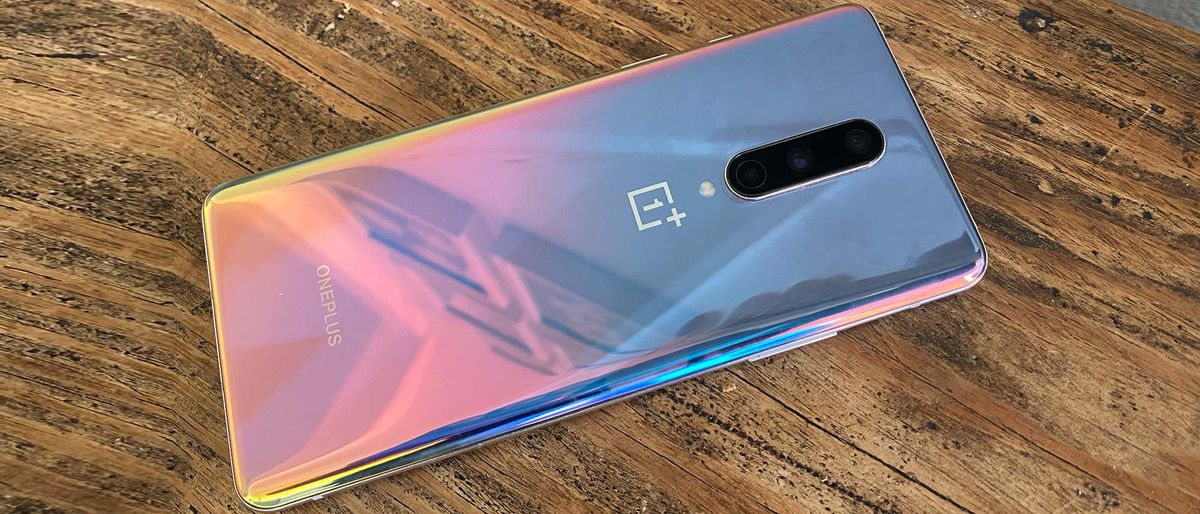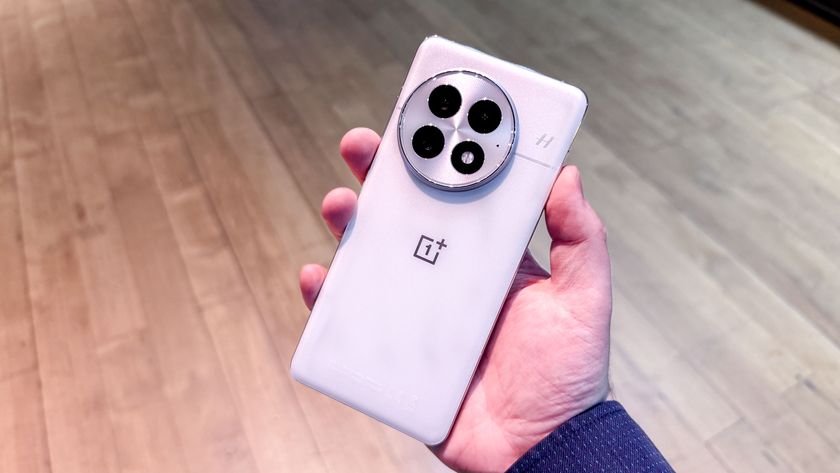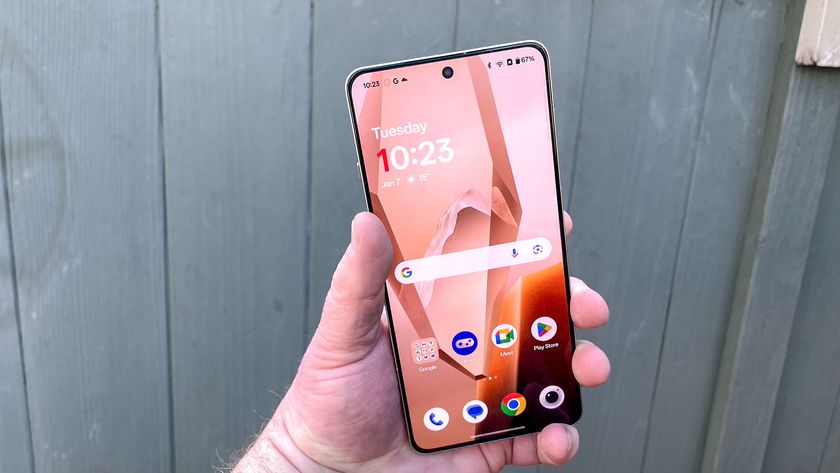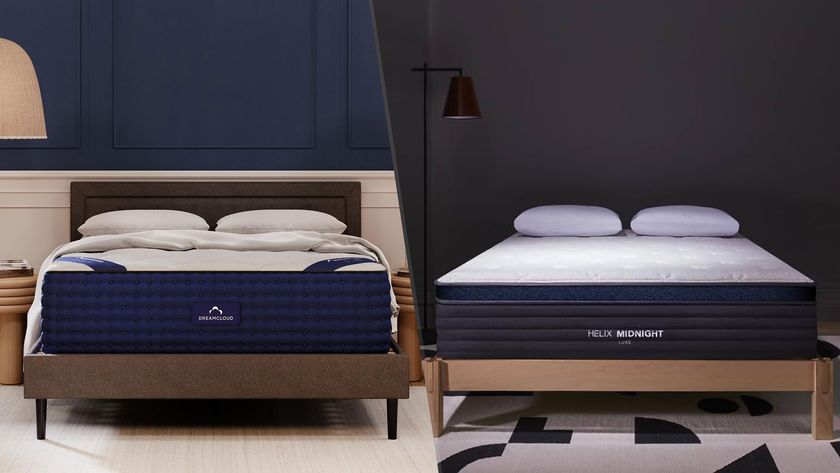Tom's Guide Verdict
The OnePlus 8 delivers solid performance, long battery life and 5G at an attractive price, but the cameras could be better.
Pros
- +
Excellent display
- +
Very good battery life
- +
Powerful processor
- +
Good low-light photos
Cons
- -
No optical zoom
- -
Middling photos overall
- -
Curved screen is prone to accidental touches
Why you can trust Tom's Guide
OS: Android 10 with OxygenOS
Display: 6.55-inch AMOLED (2400 x 1080), 90Hz
CPU: Snapdragon 865
RAM: 8GB, 12GB
Storage: 128GB, 256GB
Rear cameras: 48MP main (f/1.7), 16MP ultra wide angle (f/2.2), 2MP macro camera
Front camera: 16MP (f/2.0)
Battery size: 4,300 mAh
Charging speed: 30 watts (included charger)
Size: 6.3 x 2.9 x 0.31 inches
Weight: 6.3 ounces
OnePlus has always courted a reputation as the phone maker you turn to when you don't want to spend big bucks on premium features. That's as true as ever with the OnePlus 8, especially as OnePlus courts the high-end of the smartphone market with its more fully featured — and higher-priced — OnePlus 8 Pro.
The OnePlus 8 lacks some of the flashier capabilities found in its upward-climbing sibling, but it's still one of the best Android phones. It boasts a top-of-the-line processor, big battery and gorgeous display. Just as important, OnePlus has reined in the price on this model. It's not a bargain on the level of the OnePlus Nord — assuming you can get your hands on that budget phone — but the OnePlus 8 proves you don't have to put up four figures to enjoy a top Android phone.
Are the tradeoffs you have to make for the OnePlus 8's comparatively lower price worth it? Our OnePlus 8 review finds that they generally are, though fans of superior mobile photography may be put off by some of this phone's compromises.
- OnePlus 8 Pro review
- OnePlus 8 vs OnePlus 8 Pro: Which phone should you buy?
OnePlus 8 review: Price and release date
The OnePlus 8 costs $699, which gives you a phone with 8GB of RAM and 128GB of storage. To bump the memory to 12GB and double the storage to 256GB, you'll need to pay an extra $100. The phone goes on sale at Amazon and on OnePlus' website on April 29.
The $699 price for the OnePlus 8 is noteworthy, in light of the $899 OnePlus is charging for the OnePlus 8 Pro. By scaling back some of the features in this new round of flagship phones, OnePlus can still offer a device that costs the same as the iPhone 11 and a full $300 less than the Galaxy S20. (We've got an in-depth breakdown on what features you're giving up in our OnePlus 8 vs. OnePlus 8 Pro comparison.)
Both T-Mobile and Verizon sell the phone. You’ll pay a little bit extra for the phone at Verizon, where a version that works on the carrier's 5G network costs $799. That works out to $33.33 a month over 24 months of payments. Before you buy the OnePlus 8 at Verizon, you should know that it has a different design than other OnePlus 8 models to accommodate the antenna needed to connect to Verizon's 5G network. That means cases that fit other OnePlus 8 models won't fit the version Verizon sells.
As for T-Mobile, it's selling the phone for $699, or $29.17 a month if you spread out payments over 24 months. A deal at T-Mobile lets you get the phone for half off if you trade in an eligible phone or open a new line with the carrier. (Find other OnePlus 8 deals in our guide on how to order the OnePlus 8.)
Because the OnePlus 8 includes a 5G modem, you'll be able to use the phone on those carriers' 5G networks where available — though only the Verizon variant will support millimeter-wave connectivity for the fastest speeds possible.
Cheaper 5G-capable phones have come out since our OnePlus 8 review first appeared, highlighted by the OnePlus Nord, which costs less than $500. For now, though, that phone is only available in India and Europe, as OnePlus mulls whether to make the Nord available here. To get a cheaper 5G phone than the OnePlus 8, you'd have to turn to a device like the 5G option of the Samsung Galaxy A51, which is now on sale for $549 at Verizon.
OnePlus 8 review: Design
If you've been following OnePlus' most recent phone releases, you'll notice some changes with the look of the OnePlus 8. The pop-up selfie cam from the OnePlus 7 Pro is gone, as is the OnePlus 7T's teardrop notch housing the front camera. Instead, the selfie cam now resides in a punch-hole cutout in the upper left corner of the OnePlus 8's display. And while the top and bottom bezels are still there, they're also as thin as they can be, so that OnePlus can maximize screen real estate on this 6.55-inch phone.
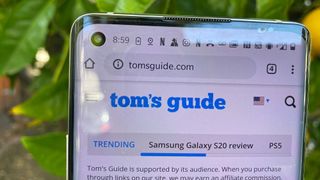
Another departure from the look of past OnePlus phones is a switch to a curved screen on the OnePlus 8, where the edges of the display wrap around the tops of the phone's sides. It certainly creates a striking look for this phone, and it makes the OnePlus 8 easier to grip than phones with flat screens and rounded edges that seem to slip out of my hands with alarming frequency. Unfortunately, the curved edges also makes it easy to inadvertently tap a part of the OnePlus 8's screen when all you're trying to do is hold or pick up the phone. I've launched more than one app I had no plans of tapping during my time with the phone.
For a phone with such a big screen, the OnePlus 8 doesn't take up that much space, at least when it comes to width. At 6.3 x 2.9 x 0.31 inches, OnePlus' phone is taller than the iPhone 11 (5.94 x 2.98 x 0.33 inches) and Galaxy S20 (5.9 x 3 x 0.31 inches), though not as wide. With 8mm of thickness, the OnePlus 8 is also fractionally thinner than Apple's iPhone 11, so you'll have minimal trouble slipping the OnePlus device into a pocket. At 6.3 ounces, it's lighter than the iPhone 11, too, though not as light as the 5.7-ounce S20.
Where OnePlus has Samsung beat involves color options. Samsung's latest phones opt for some pretty conventional color schemes, but the OnePlus 8 mixes things up with a choice between the cool tint of Glacial Green and the shifting colorway of Interstellar Glow. I reviewed the latter color and I appreciated how the Gorilla Glass back of the OnePlus 8 scaled from cool purple hues at the top of the phone to a warm pink at the bottom — an effect not unlike the sky at sunset. Your conventional sunset is less likely to pick up as many fingerprints and smudges as the back of the OnePlus 8, though.
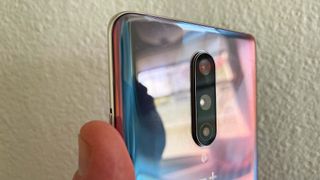
Instead of the bulging square camera bump that's become commonplace on flagship phones these days, OnePlus sticks the three rear lenses in a vertical array down the upper center of the phone. I'm less likely to put my fingers over the OnePlus 8's camera when I hold the phone in landscape mode this way. The lenses do stick out noticeably from the back of the phone, though.
OnePlus has made much of the fact that the OnePlus 8 Pro is the first of its phones to have an IP rating (IP68 to be exact, which means can be submerged in up to 5 feet of water for 30 minutes without damage). There's no such designation on the OnePlus 8, at least not on the unlocked version I'm using. (Carrier versions of the phone may be a different story.) It's a bit of a bummer you have to sacrifice this peace of mind for the less expensive of OnePlus's new flagships.
OnePlus 8 review: Display
If you pay up for the $899 OnePlus 8 Pro, you can enjoy a screen with a 120Hz refresh rate. OnePlus 8 users, however, must make do with a 90Hz refresh rate — which also happens to be noticeably faster than the 60Hz rate found on most phones these days.
I honestly don't think that this is much of a tradeoff between the two versions of the OnePlus 8. Yes, the Pro model features smoother scrolling and it has an MEMC mode to upscale Netflix and YouTube videos to 120 frames per second. But whatever improved scrolling you get from 120Hz vs. 90Hz escaped my eye when I used a Galaxy S20 Plus (with its 120Hz refresh rate turned on) alongside the OnePlus 8's 90Hz screen. In other words, the OnePlus 8 lets you enjoy the benefits of faster scrolling at a lower overall price. And you don't have to downscale the resolution on your OnePlus 8 to enjoy this feature the way you do on Samsung's S20 phones.
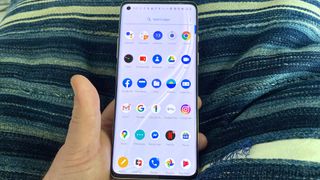
With a maximum brightness of 1,100 nits, the OnePlus 8's AMOLED screen is plenty bright enough to see in bright sunlight. When I went out to shoot photos with the phone, I never had to max out the brightness (and drain the battery faster) to see the OnePlus 8's on-screen controls.
Watching trailers for both No Time to Die and Cats on both the OnePlus 8 and Galaxy S20 Plus, I thought the OnePlus 8 matched up well against Samsung's more expensive phone in the color department. Colors looked a little more vibrant on the S20 Plus, but they also had a bluish cast, particularly when James Bond or assorted Jellicle cats were skulking around in darker scenes of their respective movies.
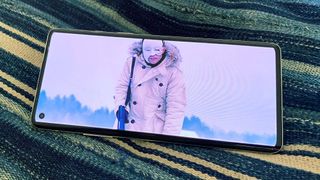
Our test numbers bear that out. The OnePlus 8 registers 155.7% of the sRGB color spectrum, which isn't as much as the S20 Plus' 222.4% result (though it does beat the iPhone 11's 113% tally). But colors are more accurate on the OnePlus 8, which has a Delta-E rating of 0.25, compared to 0.36 for the Galaxy S20 Plus. A score of zero is perfect on this test. You're getting an excellent display with the OnePlus 8 that captures color well.
OnePlus 8 review: Cameras
A bigger tradeoff that OnePlus 8 owners have to make, at least compared to the OnePlus 8 Pro, concerns the cameras. While the Pro model features four lenses, the OnePlus 8 sports only three — and one of those isn’t a telephoto lens. Instead, the 48-megapixel main shooter with its f/175 aperture and 16MP ultra wide camera are joined by a 2MP macro lens. That's great, in theory, for taking detailed objects, but if you want to zoom in, you're at the mercy of a digital zoom that can add noise to your shots.

If you shoot a lot of photos where you can get up close and personal with your subject, the macro lens may come in handy, but I'd rather have a good zoom lens on my phone. If a phone does come equipped with a macro lens, I wish it performed more consistently than the one on the OnePlus 8.
While this close-up shot of a tulip arrangement captures the folds and patterns of the purple tulip's leaf, too many of the macro shots I took with the OnePlus 8 had too much of a blur that I didn't notice until I was able to look at my photos on a larger screen than the phone's viewfinder. There's probably an art to taking macro shots, but the OnePlus 8 certainly doesn't help you discover it.
As for the lack of a telephoto lens, you see the disadvantage OnePlus 8 is working at when you stack it up against a phone capable of an optical zoom like the Galaxy S20 Plus. (The lower cost S20 would be a better comparison to the OnePlus 8, but the S20 Plus is what I have on hand during this time of sheltering in place.)
This shot of the Oakland skyline from across the San Leandro Channel shot at a 2x zoom looks generally the same on the OnePlus 8, as it does on the S20. But focus in on the buildings in the background, and you can see that they stand out more sharply in the Samsung phone's rendering. The S20 Plus also captures more gradients of blue in the spring sky.
The more you zoom in, though, the greater the disparity becomes. The OnePlus 8 maxes out at a 10x digital zoom, and by that point, the photo looks like nothing you'd care to share — everything's fuzzy and out of focus and the colors are decidedly muted. The S20 Plus can use lossless zoom to still deliver a focused photo where Oakland's Tribune Tower pops out against the sky and you can clearly read the Wells Fargo sign on the building next to it. If you count on your camera phone to zoom in for more details, you'll want to look beyond the OnePlus 8.
The OnePlus 8 makes a better show of it when you're turning to its other lenses for photos. OnePlus' phone did a decent job with this jar of multicolored jellybeans on my porch, though it struggles with figuring out where the glass jar ends and the mass of jelly beans begins. The Galaxy S20 Plus does a better job distinguishing between those two objects, even if it has a warmer color cast than I think is accurate.

Note that the OnePlus 8 uses pixel-binning with its main lens to present 12MP photos with better dynamic range. You have the option to switch to 48MP photos, though that feature works best in brightly lit scenes. In the case of the jelly bean jar, you get a photo that's closer to what the S20 Plus shoots by default, with less glare from the glass jar.
The OnePlus 8 seems to have trouble focusing with some photos as I found out when photographing a bowl of pork belly that whipped up for dinner. The glaze on the pork glistens in the OnePlus 8 shot, though you can't really make out the individual grains of rice that the S20 Plus had a better time capturing. More significantly, the kale salad in the background of the OnePlus 8 shot is clearly out of focus, and not in an artistic way. It's just a mass of green, whereas the S20 Plus is able to keep both the main dish and the salad in sharp contrast.
To see how the OnePlus's ultra wide angle lens fares, I went to a nearby shoreline to take a photo of a statue in front of some houseboats. I actually like the OnePlus 8's effort here, as it produced a bright, well-composed shot that matches up well against the Galaxy S20 Plus' output. The S20 Plus darkens the scene a little too dramatically for my tastes, while the OnePlus accurately reflects what a sunny day it was when I took these photos.
Switching to the wide angle, though, the OnePlus 8 falters. The formerly bright colors are now fairly dull. Compare the yellow trim on the houseboat — it pops in the S20's photo, while it looks muted in the OnePlus 8 shot. The angle on the S20 Plus is also wider, capturing more background detail.
There are few instances where the OnePlus 8 outperformed the Galaxy S20. The OnePlus 8's Nightscape mode, for example, does a superlative job in low-light. A mural on a local shop is still heavily detailed in the OnePlus 8's photo, even if the flowers in the upper right color got a little washed out. (The S20 Plus struggled with those flowers as well.) The S20 Plus, while showing more coloration in the night sky, also imposes too warm of a cast, while the cool look of the OnePlus 8's shot feels like a better representation of the scene.
Neither phone really stood out with their attempts to take a portrait of my daughter, though I think the OnePlus 8 has the better overall shot. It struggles separating her hair from the background blur, catching more than a few strands in the bokeh effect. But the colors are more accurate and vibrant, even if the OnePlus 8 has a little bit of trouble with shadows on this bright, sunny day. The S20 Plus removed all the color from my daughter's face, as both phones got over-aggressive with smoothing out her skin.
That same aggression with removing any blemish or freckle appears again when we switch over to the 16MP selfie cam on the front of the OnePlus 8. Like the Galaxy S20 Plus, OnePlus' camera software wants to make my skin look as smooth as possible, accuracy be damned. I think the OnePlus 8 shot better reflects my skin tone than the S20 Plus, which makes it look like I'm wearing bronzer. The background blur in the S20's photo is more stylish, though.
My testing of the OnePlus 8's video capture capabilities hasn't been as extensive, but so far I like what I've seen. By default, you shoot video at 1080p/30fps resolution, though if you dig into settings, you can upgrade to 4K video at 60fps. (Be prepared to eat up a lot of storage space if you do that.) Video I shot of my daughter running to and fro appeared steady, which I'll credit to the OnePlus 8's hybrid stabilization that taps into both OIS and EIS technologies.
OnePlus 8 review: Performance
Like the other leading Android phones coming out this year, the OnePlus 8 features Qualcomm's Snapdragon 865 system-on-chip, which promises better performance and more efficient power consumption than the Snapdragon 855 that powered the previous OnePlus flagships. (Since our review, phones using the Snapdragon 865 Plus, such as the Galaxy Note 20, have come out, and they figure to outperform their 865-powered counterparts.) OnePlus augments that chipset with either 8GB or 12GB of RAM. Our OnePlus 8 review unit featured 12GB of RAM alongside 256GB of onboard storage.
That extra RAM gave the OnePlus 8 a boost when we ran Geekbench 5, a test that measures overall performance. The OnePlus 8's multicore score of 3,387 landed squarely among the top-performing Android phones we've seen this year — ahead of the Galaxy S20 (3,147), but behind the LG V60 ThinQ 5G (3,420).
| Phone | Processor | Geekbench 5 multicore score |
| OnePlus 8 | Snapdragon 865 | 3,387 |
| iPhone 11 | A13 Bionic | 3,251 |
| Galaxy S20 | Snapdragon 865 | 3,147 |
| LG V60 ThinQ 5G | Snapdragon 865 | 3,420 |
| OnePlus 7T | Snapdragon 855+ | 2,759 |
| Google Pixel 4 | Snapdragon 855 | 2,329 |
More impressively, the OnePlus 8 beat the iPhone 11's multicore Geekbench 5 score of 3,251, showing that the gap between iPhones and leading Android devices grows smaller all the time — at least when you pack your Android phones full of RAM. (The iPhone 11 Pro and iPhone 11 Pro Max handily bested the OnePlus 8's multicore result, while the iPhone 11 had a better single-core result — 1,333 versus 920 for the OnePlus 8.)
On the graphics front, the OnePlus 8 delivered comparable results to other Snapdragon 865-powered phones, producing a score of 1,322 frames (21 frames per second) on the GFX Bench Aztec Ruins Vulkan test. That's in line with what we saw from the Galaxy S20 (1,319) and LG V60 (1,313), but behind the iPhone 11 and its 1,481-frame (23 fps) result.
The OnePlus 8 lagged other phones when it came to a real-world test where we use Adobe Premiere Rush to transcode a 4K video to 1080p after applying an effect and transition. It took the OnePlus 8 1 minute and 43 seconds to pull off that task — nearly 30 seconds behind the Galaxy S20's 1:15 time. The iPhone 11 continues to set the pace here with a 45-second result.
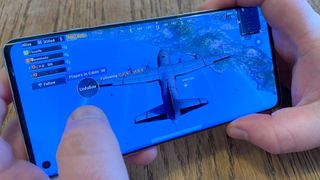
When using the OnePlus 8 over a week-plus worth of testing, though, I didn't notice any lags in performance. I could switch between apps with ease and demanding games like PUBG Mobile played on the OnePlus 8 without any hiccups or stutters. Other phones may out-muscle the OnePlus 8, but you'll certainly get comparable performance from this OnePlus flagship without having to pay a comparable price.
OnePlus 8 review: Battery life and charging
The OnePlus 8 comes with a 4,300-mAh battery — bigger than the 3,800-mAh power pack in the OnePlus 7T though not as large as the 4,510 mAh battery you'll get by paying up for the OnePlus 8 Pro. That shouldn't matter too much, as the OnePlus 8 delivers superlative battery life, though that result comes with a caveat.
When we put the OnePlus 8 through the Tom's Guide battery test — that's continuous web-surfing over T-Mobile's LTE network with the display set to 150 nits of brightness — the new OnePlus phone lasted an average of 11 hours and 4 minutes. The best phone battery life for the devices we've tested tops 11 hours, so the OnePlus 8 finds itself in rare company, even if recent flagships like the Galaxy S20 Ultra and LG V60 ThinQ outlast it.
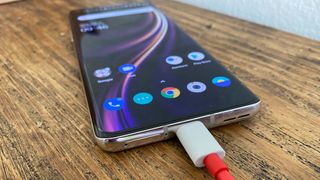
That 11 hour-plus time comes with the OnePlus 8's refresh rate set to 60Hz. Opt for the faster refresh speed, and battery life takes a hit. When we ran our battery test after setting the OnePlus 8's display to a 90Hz refresh rate, the average result dropped to 9 hours and 55 minutes, which is more in line with the average smartphone's performance. Losing an hour of battery life to enjoy one of the OnePlus 8's marquee features isn't ideal, but it's a tradeoff some users won't mind. It's also not as steep as the 3-hour difference we saw when testing the Galaxy S20 Ultra's battery with a 120Hz refresh rate turned on.
OnePlus finally added wireless charging support to the OnePlus 8 Pro, but the standard OnePlus 8 model remains stuck in the past with only wired charging capabilities. At least that charging is ridiculously speedy, thanks to OnePlus' Warp Charge 30T technology. Using the included 30-watt charger, I routinely saw the OnePlus 8 go from a drained battery to a 68% charge after 30 minutes. The Galaxy S20 Plus and iPhone 11 Pro both hit 55% after 30 minutes of charging.
OnePlus 8 review: Software and special features
The OnePlus 8 runs OxygenOS, an in-house version of Android 10 that adds a couple of new features like a dark mode that's compatible with more apps and optimized for better battery life. OnePlus has also introduced new dynamic wallpapers that shift tones based on ambient lighting.
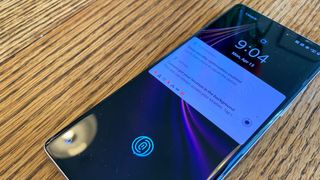
I think the highlight of the special features for the OnePlus 8, though, is the phone's in-display fingerprint sensor, a returning feature from past OnePlus flagships. The sensor's spot on the display is clearly shown with the outline of a fingerprint, and I find it more responsive and forgiving than similar features on the Galaxy S20 lineup.
The OnePlus 8 also benefits from a facial recognition feature that's a lot quicker than the iPhone's Face ID, which scans your face to unlock your device but still requires you to swipe up to move past the lock screen. Glance at the OnePlus 8 and it will launch immediately. Of course, OnePlus' face unlocking feature isn't as secure as what Apple does with Face ID, which uses a 3D scan of your face to verify your identity. That might explain why I was able to unlock the OnePlus 8 while wearing a pandemic-inspired mask over my nose and mouth. That same mask was blocked by Face ID.
OnePlus 8 review: Verdict
Normally, I'm a big advocate of opting for the less expensive of the multiple models that phone makers put out. Plus, Pro and Ultra models have flashy features that appeal to power users, but rarely justify the added cost for most smartphone owners. And while the excellent display on the OnePlus 8 won't have users feeling short-changed, the better performing cameras on the OnePlus 8 Pro just might.
As for how the OnePlus 8 measures up to devices beyond those made by OnePlus itself, there's a compelling case to be made for this flagship phone. The OnePlus 8 performs as well as any leading Android device and even makes the iPhone 11 sweat a little. You'll get very good battery life — at least when the phone's faster refresh rate isn't taxing the battery — and the color schemes on the OnePlus 8 help this phone stand out from a selection of increasingly indistinguishable black smartphones.
The big question in any OnePlus 8 review comes down to the camera. If you want an Android phone that produces the best possible shots, you'll want to pay up for Samsung's Galaxy S20 models. But if you don't really make use of optical zooms and don't mind photos that don't measure up to what the best camera phones produce, the OnePlus 8 can save you anywhere from $100 to $300 on your next handset.
Philip Michaels is a Managing Editor at Tom's Guide. He's been covering personal technology since 1999 and was in the building when Steve Jobs showed off the iPhone for the first time. He's been evaluating smartphones since that first iPhone debuted in 2007, and he's been following phone carriers and smartphone plans since 2015. He has strong opinions about Apple, the Oakland Athletics, old movies and proper butchery techniques. Follow him at @PhilipMichaels.
